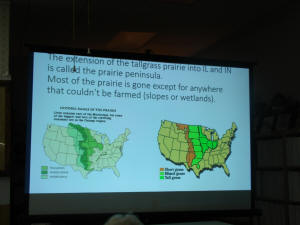|
Struebing is a Master Gardener and Master Naturalist
and knows the land of central Illinois.

Logan County is at
the heart of the tall grass prairie in Illinois.
“Illinois is known as the prairie state, but not
everyone knows where that name came from,” said Struebing. When the
first French traveled to Illinois in the 16th and 17th centuries,
they saw a landscape that is very different from what we see today.
Those explorers saw a seeming ocean of tall grass waving in the wind
when they first arrived, like the waves on the sea. There were no
trees in central Illinois on the very flat land. The word prairie is
a French word to describe the illusion of waves that stretched
before them.

But what created this topography?
The glacial period of the earth when the mountains of ice moved
south out of what is now Canada created the very flat areas of
Illinois. The massive weight of the Wisconsin and Illinois glaciers
moving forward and back as they grew and melted scraped the land
flat creating our current landscape.
The glaciers also ground up the rock in their way and created
gravel. When the glaciers retreated, they left a flat land in most
of Illinois. It is easy to see where the glaciers ended their march
south. The descending land between Atlanta and Lincoln marks the
so-called terminal moraine of the Wisconsin glacier, the farthest
south it traveled. The descent of topography on Interstate 155 near
Delavan is the end of the Illinois glacier. The result of glacial
movement was the flat land covered with crushed rock. The Illinois
glacier moved the farthest south of the two.
Once the glaciers retreated north, melting because of the warming
climate, there were some spruce trees left in their wake. The land
was a sort of tundra, or frozen ground.
The next change to occur was wind from the west blowing fine silt
into the area. This silt was called loess and created the rich soil
in central Illinois, covering the gravel sometimes to a depth of 200
feet.
As the climate warmed, the spruce trees died out and the first of
the grasses started to grow on this flat land, between eight and ten
thousand years ago.

The center of the United States was once a sea of prairie grass from
Ohio to a swath of states extending from Canada to Texas.
Because of rain fall totals, Illinois, Indiana and
Ohio had the tallest of the grasses growing on their land. The
states west of Illinois had shorter grasses, while the grass in
Nebraska and Kansas was shorter yet, due to reduced rainfall.
At one time, Illinois had twenty-two million acres of grassland
within its borders. Only a fraction of that remains today. The rich
soil, plentiful rain, and frequent fires were the perfect
environment for growing these grasses, sometimes reaching heights of
eight feet.

[to top of second column] |

Huge herds of buffalo tilled the land with their
wanderings, adding to the factors that produced the perfect
environment. “There were ten kinds of grasses and thirty types of
flowering grasses. The most common tall grasses in the so-called
prairie peninsula were Big Blue Stem and Indian Grass,” said
Struebing. When the first explorers arrived this is what they saw,
the waving grasses that resembled ocean waves, and they named it
prairie.
They also found a land of deep rich soil that was
very difficult to farm. The grasses had deep roots that bound the
soil together.
The land was also very wet, a remnant of the tundra left by the
glaciers and the warming climate.
The biography of Illinois now gives way to technology. An inventor
named John Deere developed a plow with a sharp smooth metal blade
that tore through the soil, and a creative Irishman named Scully
came up with a way to drain the land.
The waving grasses of the prairie gave way to the waving corn fields
we see today.

The grass prairie is gone
forever, but it had many benefits for the environment.
“There are spots of tall grasses in old cemeteries
and along old railroad right-of-way, but the conditions that created
thousands of years of grasslands in Illinois are gone forever. Only
one tenth of one percent of the original millions of acres of
grassland remains,” said Struebing.
So the history of Illinois has left us with several benefits that we
still enjoy today. The Illinois and Mississippi Rivers are gouged
out remnants of the retreating glaciers. The deep bedrock of gravel
provides building material. The water flowing through the gravel
that is sometimes hundreds of feet deep provides clean drinking
water for millions of people.
And the soil in central Illinois, the rich deep soil provides the
best farming resource in the world.

Jim Struebing is passionate about the prairie and what it provided
during its existence. “The factors involved in the development of
the tall grass prairie can no longer be replicated, but there is
something people can do to honor this part of Illinois’ history. I
have several small plots of prairie grasses in my yard and some
flowering prairie grass,” he said. Anyone can have a small piece of
Illinois history in their yard. And the state of Illinois has
discovered the benefits of slow growing prairie grass. The sides of
interstates are seeded with it and now require less mowing.
The flora of Illinois’ early biography can still be with us.
The Logan County Genealogical and Historical Society meets the third
Monday of each month at their research facility across from the
newly remodeled Lincoln Depot at 6:30 p.m. The public is invited to
attend, and they always have an interesting and informative
presentation.
[Curtis Fox] |